
17 minute read
LUBRICANT TECHNOLOGY

A word in your Shell-like

Racecar investigates the highly complex world of Formula 1 fuels and lubricants
By Stewart Mitchell

The evolution of fuels and lubricants in Formula 1 is one of the most critical and untold stories of the sport in the current era. The introduction of the hybrid regulations in 2014 changed the engineering formula for the internal combustion powertrain from an air-limited, mechanically-restricted formula to an energy-limited one.
This shift in concept altered the engineering approach, and set the road map to the world’s most effi cient race powertrains, now producing over 1000bhp from the combination of 1.6-litre, turbocharged V6 internal combustion engine (ICE) and energy recovery system (ERS) at a thermal effi ciency of over 50 per cent.
For the current turbocharged V6 formula, the restricting element is no longer the oxidising component of the combustion, it is the hydrocarbon element. This forces engineers to think completely diff erently about the whole process of combustion.
The absolute power of the engine derives from its ability to transfer the joules of energy stored in chemical form into kinetic energy. The challenge is to adapt the airto-fuel ratio and combustion parameters to extract the most energy out of each fuel droplet, rather than simply adding more.
The number of joules of energy entering a contemporary F1 engine can be considered a constant as the regulations fi x a fuel mass fl ow rate of 100kg/h. The ratio of energy entering the engine in fuel form to that turned into useable kinetic energy is the primary target for the fuel engineers.
‘The 50 per cent plus thermal effi ciency of the current crop of Formula 1 engines is extremely impressive, and most of that is attributed to the mechanical design of the engines,’ explains Benoit Poulet, Formula 1 fuel development manager and trackside team leader at Shell. ‘However, the fuel contributes 25 per cent of the functional thermal effi ciency of the engine.
‘Of course, the engines were not at 50 per cent thermal effi ciency on day one of these regulations in 2014, so this journey has been ongoing for the last seven years.’

Fuel evolution
The limiting factor of the naturally aspirated, fi xed displacement, air-limited engines was how high they could rev, which is a function of combustion speed and mechanical stress.
Ferrari’s SF21 FIA Formula 1 World Championship contender features no fewer than seven products from its principal partner, Shell, helping it to work as efficiently as possible
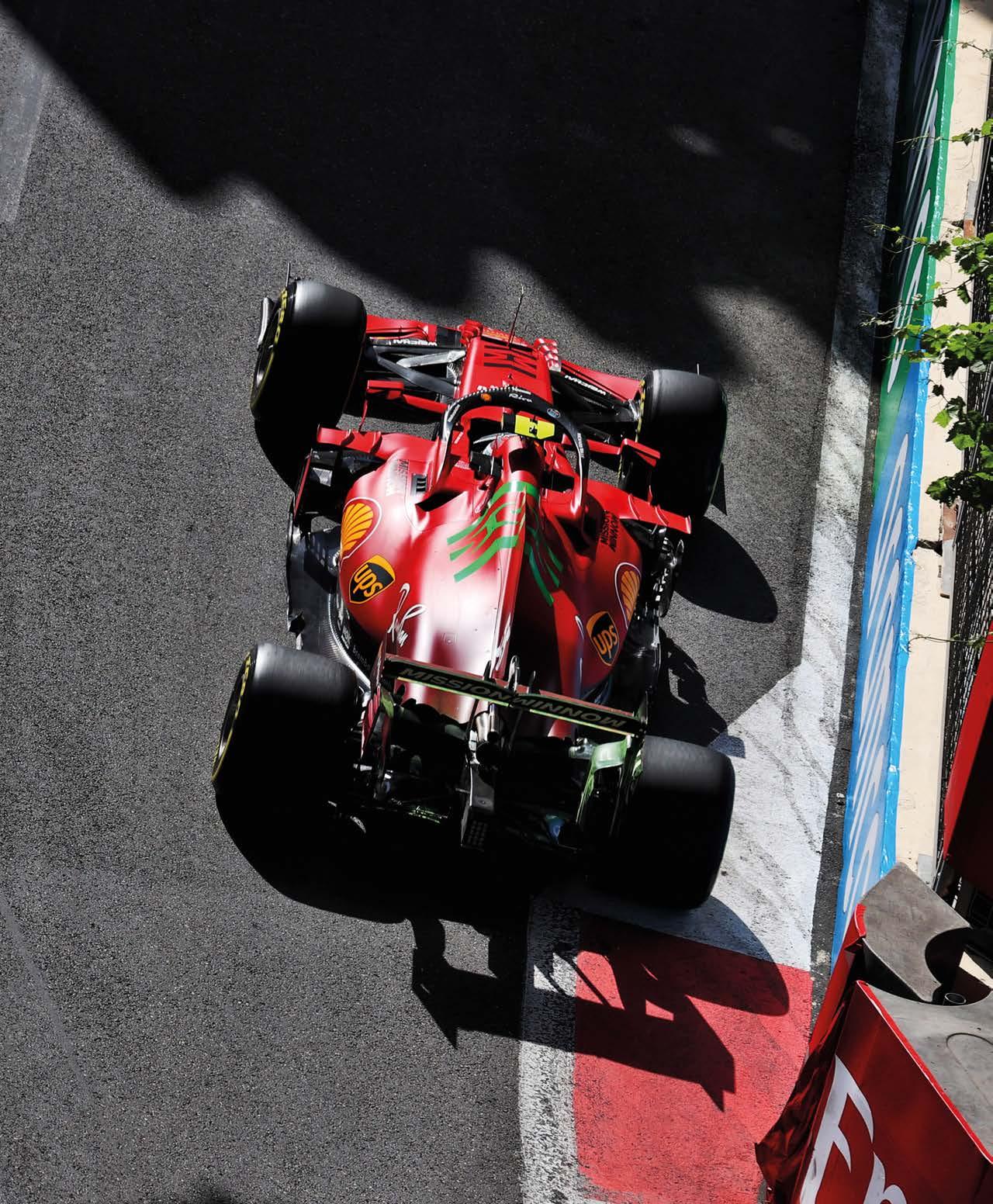
There were two major elements of the fuel formulations for that era: they were designed to balance peak power output potential (as a function of calorific value and combustion speed) and fuel consumption. The use of each was track dependent.
In the hybrid era, the mass of fuel for the race is limited and the fuel flow is limited in mass at any given time. So, the mass becomes a fixed parameter. This takes out the track dependency as it was in the past. Engineers can also trade off kilograms of fuel carried against fuel consumption and peak power, as a function of the vehicle dynamics gains to be had from carrying less fuel at certain tracks.
‘With the current hybrid regulations, which fix the fuel in mass, the track dependency is out,’ notes Poulet. ‘It is the same in Monaco as it is in Monza, and even going to Mexico as well if we also include the air pressure parameter. It doesn’t change.
‘However, although the fuel type trade-off no longer exists, you see another exchange in the current regulations set. Because the fuel flow and fuel load are prescribed in kilograms, there is scope for development of the calorific value of the fuel.
‘When the energy-limited formula came into place and research into the fuel started, Shell discovered that some fuel molecules produce significantly more energy than others. The development targets then shifted to finding how engineers can apply as much energy into one kilogram of fuel and generate the proper pressure and motion for the direct injected gasoline engine.’
The research octane number (RON), which gives a ranking of how close to the most efficient moment the spark plug can ignite the fuel, is a primary driver in the combustion development of the high-efficiency fuel.
‘In theory, you want all combustion to happen instantaneously at top dead centre (TDC),’ highlights Poulet. ‘Physics dictates that this cannot occur as combustion is a process that happens in stages. Despite this ideal being physically impossible to achieve, the engineers set about developing the fuel chemistry to go through the combustion process as fast as possible.’
Knock control
Because the current engines are turbocharged, there is a lot more motion and chaos in the combustion chamber than with the old naturally aspirated engines. So spontaneous combustion (aka knock) is a substantial limitation and consideration for contemporary Formula 1 race fuel blends.
Combustion chamber, piston crown and piston ring pack design are all critical in the mitigation of knock, which is why companies like Shell work so closely with their Formula 1 engine design squad partners at Scuderia Ferrari.
‘With the energy that you get into one kilogram of fuel, how much you will be able to condition the fuel to combust completely and as close as possible to TDC, and how quickly it will happen, has changed dramatically since the start of the energylimited formula began,’ highlights Poulet.
‘Additionally, despite the [15,000rpm] rev limit and the operating rpm of the current Formula 1 engines being significantly lower than the previous naturally aspirated, air-limited formula [now operating at peak rpm around 12,500-13,000rpm], engineers want the pressure build up from combustion to happen even faster than before.
‘When the piston starts to go down, the chamber volume increases, which means work is required to build the pressure inside the chamber until BDC.’
Efficient combustion
The combustion parameters are defined first before the mechanical geometry around it is configured. Achieving efficient combustion in a fuel-limited formula pushes engineers to run the engines ever leaner, and consequently drives technology such as pre-chamber ignition and the use of homogenous charge combustion ignition (HCCI).
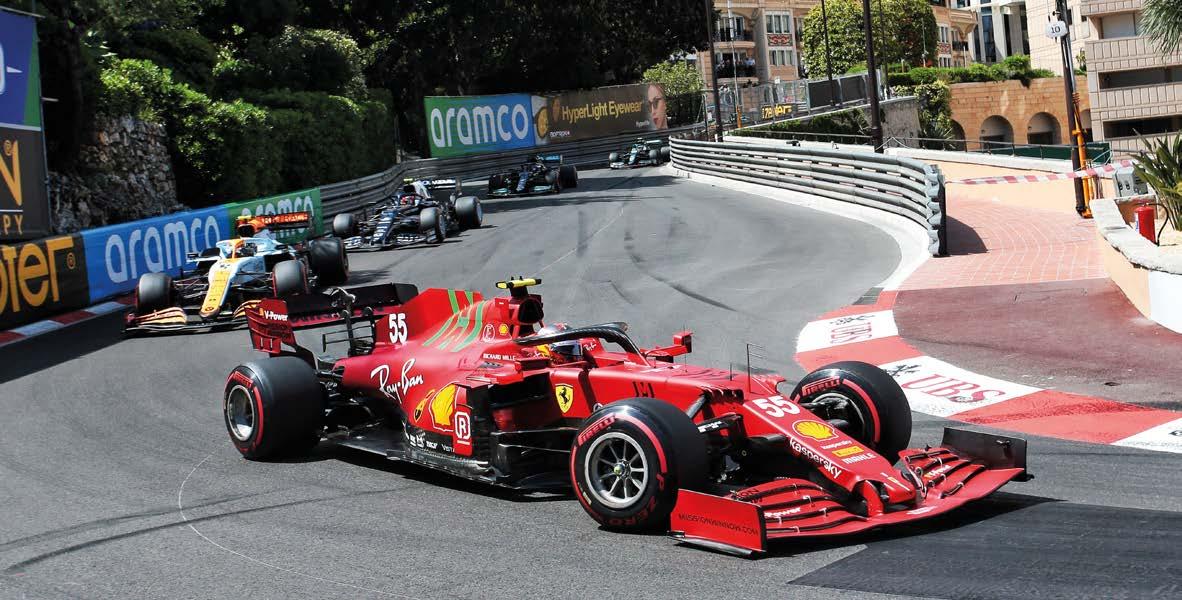

Shell’s bespoke racing fuels are designed to extract maximum efficiency from every molecule that goes into Ferrari’s 1.6-litre, turbocharged, V6 race engines
‘Every fuel molecule must meet the required amount of air to satisfy the peak efficiency in desired power regions of output,’ says Poulet. ‘Running the engine lean pushes the combustion into a more knock sensitive and unstable state as every non-stoichiometric event can disturb the ideal combustion.
‘Hardware and fuel formulations produce the basis from where high performance, ultra-lean combustion science can prevail in an ultra-high load environment, such as that seen in contemporary Formula 1 powertrains. That is where our development of the fuel behaviour in a lean environment prevails. We now have stable, precise, lean and powerful combustion in all load cases.’
Calorific density optimisation is a huge part of development as the only control parameters regarding fuel specified is the type and its weight. Improving calorific density can yield performance gains, as packaging the specified 110kg of fuel in a smaller volume will aid vehicle dynamics.
When engineers look to increase the potential of a kilogramme of fuel there are trade-offs between the weight of molecules and their overall performance.
‘Formula 1 tightly regulates the fuel constituents, like in the road car environment,’ explains Poulet. ‘The critical parameters of density, combustion speed and calorific value are thereby the nature of the prescribed compounds. Ninety nine per cent of the compounds found in the Shell Formula 1 fuel are also in its high-power road car fuels.
‘Shell simulates various fuel densities to see how it affects engine performance in the Formula 1 operating window at the given load case. The higher density fuels we have found recently have enabled the 110kg of starting fuel load to package in less volume, allowing the chassis and aerodynamic teams to design a physically more efficient car.’
Mechanical elements
The Ferrari SF 21 engine is the cooptimisation / co-design effort of Ferrari’s mechanical engineering team and Shell’s fuel and lubrication team. Neither develops without coinciding with the other.
When it comes to the piston crown, combustion chamber shape and the piston ring pack design, Shell wants to come with the capability to map the influence of the fuel, and vice versa, quickly.
For this, the company has developed significant digital combustion modelling and simulation capabilities within the Shell group, leveraging the power of the Ferrari Formula 1 team.
‘Suppose some developments influence the mechanical elements of the engine, such as compression ratio, which is the primary driver in engine efficiency,’ notes Poulet. ‘In that case, that will lead to another journey in pressure and temperature inside the combustion chamber. Feeding these mechanical alterations into Shell’s modelling software, the algorithms can generate, compare and contrast millions of possible fuel formulations that immediately identify the regions of constituents that could achieve, or exceed, the desired combustion performance targets.’
Since 2017, Shell has been heavily developing algorithms to help it identify the optimal fuel recipe for Formula 1. Shell’s optimisation algorithms process over 250,000 formulations of fuel per year for the Scuderia Ferrari Formula 1 engine. It maps almost every fuel recipe that could be made, and then digitally tests it with the Ferrari Formula 1 engine model.
System optimisation
Along with extracting high performance from the lean burn principle, Formula 1 must consider post-combustion energy because Formula 1 engines are turbocharged. The turbocharger has a very different demand compared to the crankshaft torque requirement from the engine, as Poulet explains: ‘This is a system engineering optimisation task as, if you isolate the internal combustion engine from the turbocharger, the powertrain would not be optimised for peak power performance.
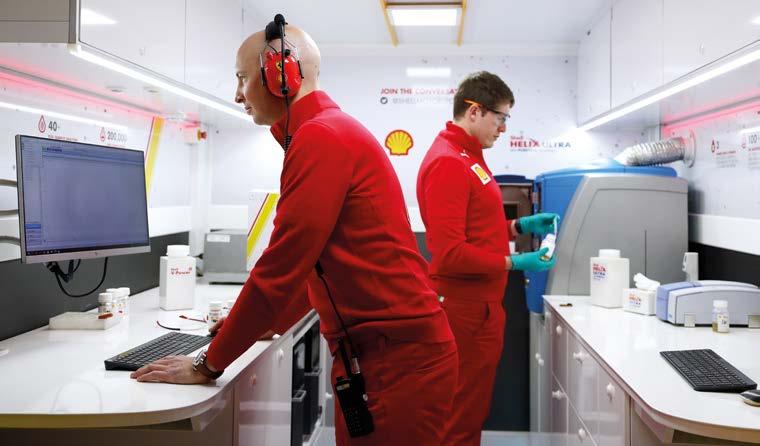
Benoit Poulet
‘An example of this would be optimising the compression ratio to generate an improvement in thermal efficiency. This is great for mechanical torque at the crankshaft, but removes enthalpy from the exhaust gas and the turbine. The enthalpy removed from the exhaust gas cannot be recovered from the hybrid part on the turbocharger, and so you reduce the scope for recovery and, therefore, deployment of the MGU units on the car.
‘Overall, a lack of consideration for the enthalpy of the exhaust gas postcombustion in a current Formula 1 engine will not yield the most efficient solution.
‘Formula 1 is not a design of experiment that has no limit. With the experience we have, we can refine the fuel, engine and mapping to improve the operation. This may see losses in enthalpy in the exhaust gas that will sacrifice some potential on the ERS side but, if that yields a higher potential in overall efficiency for race conditions, it is considered.’
As the turbocharger has acoustic and oscillating pressure effects on the exhaust flow, it is also used as an input to fuel formulations to identify recipes that may mitigate some of these adverse effects on efficiency.
‘Even with today’s technology, with the advancements in AI and compute for simulation, it would be impossible to simulate all of the pressure wave oscillations caused by the exhaust gas as it exits the combustion chamber, travels down the exhaust pipes and interacts with the turbine,’ says Poulet.
‘However, it is possible to generate a very accurate energy map and enthalpy of the exhaust gas as it enters and passes through the exhaust system. We take this type of information from a 1D simulation into a 3D space, which gives us quite a precise picture of the potential of the gas exchange through the engine, exhaust and turbocharger feedback system.’
Working alongside the Ferrari engineers to design and develop back pressure reducing exhaust designs that capitalise on the post-combustion enthalpy of the exhaust gas is another significant part of the development process and partnership between Shell and Ferrari.
‘Any energy released as pressure or sound out of the engine can be harvested by the turbo and the electric machine attached to it,’ notes Poulet. ‘The flow through the exhaust before the turbine is critical for the overall performance as it contributes to the only unlimited energy recovery source in the car’s ERS.’
Lubrication side
Efficient use of the energy to increase the power output in an engine would not be complete without considering lubricants.
‘We must consider the oil when we speak about the total power output over 1000bhp for a powertrain system as power dense as the current Formula 1 engines,’ says Poulet. ‘There are hundreds of kilowatts of energy released as heat, which must be extracted from the source areas of the heat and expelled to the outside air.
‘Of course, the lubrication side of the oil must prevent contact between sliding surfaces, but the heat extracting capability of the current oils is better than ever.’
So, not only must the oil in current Formula 1 engines lubricate and cool the engine components and turbo, and not generate wear, but it must also get all the calories of heat away from the engine in the most efficient way, all the while contending with temperatures as high as 1000degC without any oxidation or breakdown.
With an energy-limited system, mechanical efficiency is the biggest contributor to overall efficiency. Without friction, there would be no mechanical losses in the engine’s operation, which, of course, is impossible. The lubricant therefore separates mechanical elements of the engine with a fluid film that allows them to pass over each other without contact.
The FIA and Formula 1 have increased the durability and reliability requirements of the powertrain. Ten years ago, each engine only had to complete two race weekends, whereas now, every Formula 1 engine completes more than seven race weekends, or over 5500kms, more akin to the mileage covered by the race-winning car at the 24 Hours of Le Mans.
Shell engineers working in a mobile laboratory testing fuel and oil samples for evaluation and development
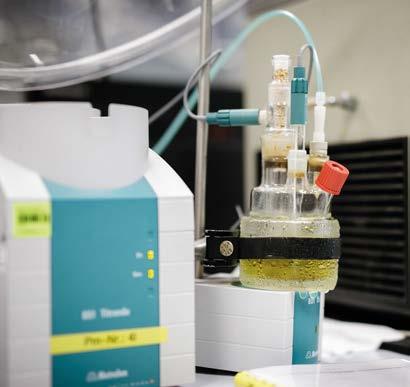
Shell F1 race fuel test formulation undergoing experiments in the laboratory
Heat control
‘A formulation of a Formula 1 lubricant that must contend with extracting a considerable amount of heat, preventing sliding contact under all race conditions, and maintaining engine wear throughout the race is very challenging to find,’ says Poulet. ‘It must be thin to achieve extreme sliding and boundary layer efficiency between the mechanical elements through the engine, but the other characteristics require very different chemistry. To tackle these challenges, Shell has developed a technology it calls GTL, a base oil technology taking natural gas and combining the natural gas atom into longer chains, making them more stable in all sorts of high-stress conditions.’

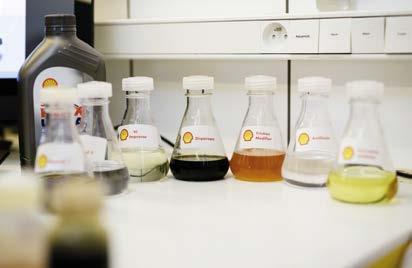
Racing fluid test equipment at Shell’s Formula 1 laboratory
Shell additive packages to improve the performance of its lubricants
Unlike mPAO synthetic base oils, which can have as little as 10 per cent homogenised synthetic base oil constituents, the GTL technology developed by Shell takes the atoms of natural gas (methane) and combines them in a process that includes exerting huge pressure on the gas until it builds a liquid with the desired chain properties. In this case, the GTL process makes the resulting lubricant a 100 per cent synthetic solution, built atom by atom into chains. ‘It is like being able to do the perfect recipe all the time,’ says Poulet.
‘The oil formulation not only needs to be the combination of low viscosity to impose a low coefficient of friction, while maintaining a buffer of oil to avoid metallic contact and have high thermal capacity and conductivity, but it must also have low volatility parameters because the FIA regulates oil consumption. Depending on the engine’s characteristics, the distribution between these different parameters is not always even and often sees one characteristic more highly weighted than another.’
Traditionally, increasing power in a race engine increases the heat generated. That additional heat must be contained if engine efficiency is to improve. However, the higher the chamber temperature, the more volatile it is and the higher the risk of knock. Additionally, as Formula 1 is so aero dependent, the aerodynamicists want the powertrain package as tight as possible, including the cooling system.
‘Tackling the heat is primarily the job of the engine oil,’ says Poulet. ‘The engine oil engineers work to develop the oil that has a higher heat capacity and a higher thermal conductivity to exchange the heat it is carrying away from the engine to the air using the smallest cooler volume possible.
‘Because the quantity of energy provided to the engine is limited, more power is created through more efficient use of that limited power. This pushes the engineers to reduce the heat rejection by developing the fuel formulation to make more energy at a lower combustion temperature.’
Formula 1 has a mission to become carbon neutral by 2030. To do so, all suppliers and partners to the sport must take respective amounts of responsibility to achieve that target.
‘Shell will continue to investigate all the elements inside the fuels to achieve this target and the extraction of their raw materials and processing stages of the fuel, not just post-combustion emissions,’ highlights Poulet.
Bio-fuels
‘Shell has been pushing for the inclusion of more bio sustainable components with no compromise. We were strong advocates of the passing of the Formula 1 fuel standards coming into regulation in 2022, including 10 per cent second-generation ethanol elements in the race fuel. We want to prove that this ethanol will be part of the journey of improving engine efficiency. This ethanol will be coming from nonfood competing land sources, so the formulation of Formula 1 fuel will not take land away from agriculture land.’
The 10 per cent ethanol fuel percentage will facilitate several things when introduced into the Formula 1 fuels from the 2022 season onwards. The construction of the ethanol molecule means it carries a lower quantity of joules per kilogramme as a combustible vapour than the equivalent volume of Formula 1 race petrol.
However, as per all alcohol-based compounds, ethanol’s evaporation characteristics mean it will extract temperature out of the combustion chamber during the initial stages of combustion. This allows the mapping engineers to lower the ignition advance, taking it closer to TDC and initiate better timed combustion. For these reasons, ethanol brings a favourable prospect to the efficiency potential of Formula 1 engines.
Design engineers can adjust several follow-on configuration parameters from these characteristics, thanks to introducing the higher ethanol content. The compression ratio is the primary beneficiary of the ethanol blend and could increase and drive the efficiency of combustion higher still.
Additionally, ethanol molecules contain oxygen. Instead of solely relying on the oxygen ingested into the engine through the intake, further oxygenation of the working fluids in the combustion chamber will occur with the higher percentage ethanol blend in the Formula 1 fuel. There is a lot of redesign and optimisation that engineers can implement into the air loop because it will no longer have the same target of kilograms per hour of oxygen from ingested air.
Shell currently has seven products inside the Ferrari Formula 1 car, including fuel, lubricants and e-fluids used to cool the power electronics, electric motors and controllers. These are designed, developed and supplied as part of the system engineering partnership the company has with the team. A fully sustainable fuel is the primary target for the upcoming generations of Formula 1 as it drives towards carbon neutral by the end of the decade.







